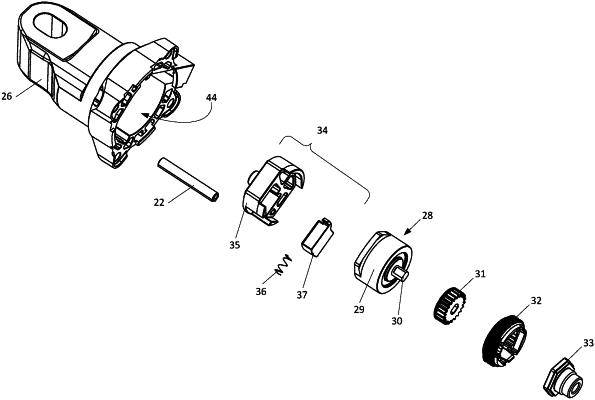| CPC F16H 25/2454 (2013.01) [A61G 7/018 (2013.01); F16H 2025/2071 (2013.01); F16H 2025/2084 (2013.01); F16H 2025/209 (2013.01); F16H 2025/2463 (2013.01)] | 13 Claims |

|
1. A linear actuator comprising:
a reversible electric motor (19),
a transmission (20), and
a non-self-locking spindle (21),
wherein the electric motor (19), through the transmission (20), drives the non-self-locking spindle (21), and
wherein the linear actuator comprises a spindle nut (22) on the spindle (21) and an adjustment element (23) secured against rotation, and
wherein the adjustment element (23) can be moved axially, in that the adjustment element (23) is connected to or integral with the spindle nut (22) on the spindle (21), and
wherein the linear actuator further comprises a quick release (27) for disengagement of the adjustment element (23) from the reversible electric motor (19) and the part of the transmission (20) extending from the reversible electric motor (19) to the quick release (27), such that the spindle (21) is rotated under the load on the adjustment element (23), and
wherein the linear actuator comprises brake means (28) connected to the spindle for controlling the speed of the adjustment element (23) under the external load when the quick release is activated,
characterized in that the linear actuator comprises a coupling (34; 52,53,54) connected to the brake means (28),
wherein the brake means (28) is configured to be in either
1) an active state, wherein the rotation of the spindle (21) is braked, or
2) An inactive state, wherein the rotation of the spindle (21) is not braked,
and wherein the coupling is (34; 52,53,54) configured to be in a state of either
3) engaged, or
4) slipping or disengaged,
and wherein the coupling (34; 52,53,54) is configured to set the brake means (28) in
1) the active state, when the coupling (34; 52,53,54) is 3) engaged, or
2) the inactive state, when the coupling (34; 52,53,54) is 4) slipping or disengaged.
|